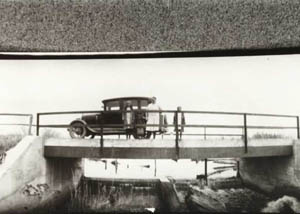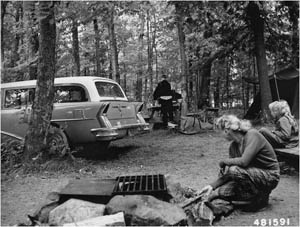“All trout streams in the state must yield the banner to the noble and lordly Namakagon.”
The booming tourism industry brought demand for fishing opportunities. The Namekagon River was already well-known for its abundant  brook trout, but published descriptions made it famous. In 1883, G. Sheilds published a fly-fisherman’s description of the Upper Namekagon River near Cable, noting that in one day’s fishing, seven in the party strung one hundred and sixty trout weighing from a quarter of a pound to a pound. In a 1885 railroad tourism publication, The Northwestern Line advertised that the Namekagon River “with its innumerable tributaries, is celebrated among sportsmen throughout the country for the quality of its brook trout, and it is a common occurrence for one fisherman to secure from the clear, deep, cool and swift waters thirty or forty pounds of the delicious fish in the sporting hours of a single day.” We can confirm that brook trout were still very abundant as late as 1893, just before stocking of Pacific rainbow trout in the river; an article in The Hayward Journal stated that it was very common “for two fishermen to bag 100 to 150 fine trout in one day’s fishing in this stream, and many times have such a party taken twice that number of speckled beauties.”
brook trout, but published descriptions made it famous. In 1883, G. Sheilds published a fly-fisherman’s description of the Upper Namekagon River near Cable, noting that in one day’s fishing, seven in the party strung one hundred and sixty trout weighing from a quarter of a pound to a pound. In a 1885 railroad tourism publication, The Northwestern Line advertised that the Namekagon River “with its innumerable tributaries, is celebrated among sportsmen throughout the country for the quality of its brook trout, and it is a common occurrence for one fisherman to secure from the clear, deep, cool and swift waters thirty or forty pounds of the delicious fish in the sporting hours of a single day.” We can confirm that brook trout were still very abundant as late as 1893, just before stocking of Pacific rainbow trout in the river; an article in The Hayward Journal stated that it was very common “for two fishermen to bag 100 to 150 fine trout in one day’s fishing in this stream, and many times have such a party taken twice that number of speckled beauties.”
From the fisherman’s perspective described by Shields in 1883, the easiest way to fish the Namekagon River in was to wade out until clear of all brush and cast the fly to deep holes below large rocks in the middle  of the channel or driftwood along a bank. We know from this description that the banks of the river were covered with brush and wood while the middle of the channel had less wood. The author described the river in May as being thirty to fifty yards wide and from one to three feet with many deep holes and rapids. Just 20 years later, a tourism pamphlet published by The North Western Line in 1904 mentions that the Namekagon River was free from brush and easily waded, contrary to the 1883 description. The lack of wood on the riverbank is confirmed in a 1907 newspaper article stating that the banks of the river were comparatively low, the river was easy to access, there was no brush to bother the angler, and the best holes could be fished from the bank.
of the channel or driftwood along a bank. We know from this description that the banks of the river were covered with brush and wood while the middle of the channel had less wood. The author described the river in May as being thirty to fifty yards wide and from one to three feet with many deep holes and rapids. Just 20 years later, a tourism pamphlet published by The North Western Line in 1904 mentions that the Namekagon River was free from brush and easily waded, contrary to the 1883 description. The lack of wood on the riverbank is confirmed in a 1907 newspaper article stating that the banks of the river were comparatively low, the river was easy to access, there was no brush to bother the angler, and the best holes could be fished from the bank.
The subtle distinction of brush being gone from the river in 1904 and 1907 is important for understanding the habitat change and decline of cold-water fish populations that occurred from logging. The Northwestern Line, the same railroad that in 1885 touted that a day’s fishing effort could secure 30 to 40 pounds of trout, published a pamphlet in 1904 acknowledging “a number of years ago the fishing in the stream was injured by logging operations, but is rapidly regaining its old-time renown.” We know from these early descriptions before and post logging, that logging effectively removed brush, stream bank vegetation and large pieces of wood from the river.
 The Namekagon River’s renown as a world-class brook trout stream was short-lived as brook trout populations faced threats on two fronts: a river altered by logging and introduction of non-native trout species. In the 1890’s the Wisconsin Fisheries Commission started stocking European brown trout and Pacific rainbow trout throughout the state. Non-native brown trout fared better than the native brook trout in a river warmed by dams and from the logging of pine, hemlock, cedar, and hardwood trees that once shaded the river (Leonard school road image). Tourism pamphlets touted that brown and rainbow trout up to four pounds could be hooked on a fly rod. Newspaper advertisements in the large industrial cities offered land for sale while promoting the abundant and large trout. Wisconsin Senate reports show that brook trout were also being stocked at this time, which could indicate that wild populations declined due to habitat loss or to overfishing. Due to habitat changes and stocking, the brown trout and rainbow trout gradually replaced the brook trout in the mainstem of the Namekagon River.
The Namekagon River’s renown as a world-class brook trout stream was short-lived as brook trout populations faced threats on two fronts: a river altered by logging and introduction of non-native trout species. In the 1890’s the Wisconsin Fisheries Commission started stocking European brown trout and Pacific rainbow trout throughout the state. Non-native brown trout fared better than the native brook trout in a river warmed by dams and from the logging of pine, hemlock, cedar, and hardwood trees that once shaded the river (Leonard school road image). Tourism pamphlets touted that brown and rainbow trout up to four pounds could be hooked on a fly rod. Newspaper advertisements in the large industrial cities offered land for sale while promoting the abundant and large trout. Wisconsin Senate reports show that brook trout were also being stocked at this time, which could indicate that wild populations declined due to habitat loss or to overfishing. Due to habitat changes and stocking, the brown trout and rainbow trout gradually replaced the brook trout in the mainstem of the Namekagon River.
A great flood in 1941 wiped out populations of rainbow trout in the Namekagon River upstream of Hayward and destroyed historical features like the narrow  gauge railroad bridge at the confluence with Big Brook. Below Hayward, a self-sustaining rainbow trout fishery has persisted in Rainbow Creek. In the Upper Namekagon, rainbow trout were sustained through annual stocking and were confined to the river, while brown trout were found in both the river and its tributaries including Big Brook, Five Mile Creek, Caps Creek, Mosquito Brook, and McDermott Brook (Table – Occurrence of brook and brown trout). Although brook trout were abundant in the river mainstem prior to logging, they were found only in the cold-water tributaries post-logging until naturally reproducing populations were rediscovered in the river in the 1970’s. After 1933, stocking of brook trout in the Namekagon River ceased until the 1970’s.
gauge railroad bridge at the confluence with Big Brook. Below Hayward, a self-sustaining rainbow trout fishery has persisted in Rainbow Creek. In the Upper Namekagon, rainbow trout were sustained through annual stocking and were confined to the river, while brown trout were found in both the river and its tributaries including Big Brook, Five Mile Creek, Caps Creek, Mosquito Brook, and McDermott Brook (Table – Occurrence of brook and brown trout). Although brook trout were abundant in the river mainstem prior to logging, they were found only in the cold-water tributaries post-logging until naturally reproducing populations were rediscovered in the river in the 1970’s. After 1933, stocking of brook trout in the Namekagon River ceased until the 1970’s.
The Wisconsin Conservation Department decreased stocking of fingerling brown trout in the 1940’s and increased stocking of yearling brown trout because of fishing pressure and the increased populations of northern pike and bass throughout the length of the river, especially near the Pacwawong and Phipps Flowages.
You Are Here:
Home > History by Era > Recreation
